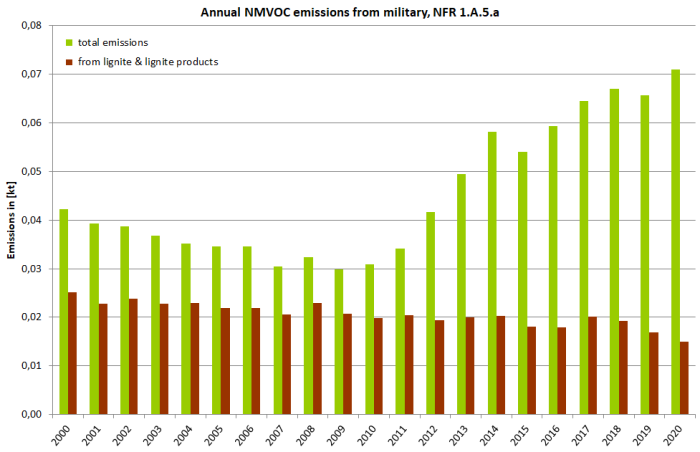meta data for this page
1.A.5.a - Other, Stationary (including Military)
Short description
In sub-category 1.A.5.a - Other, Stationary (including Military) emissions from stationary fuel combustion in military facilities are reported.
| Category Code | Method | AD | EF | ||||||||||||
|---|---|---|---|---|---|---|---|---|---|---|---|---|---|---|---|
| 1.A.5.a | T2, T3 | NS | CS | ||||||||||||
| NOx | NMVOC | SO2 | NH3 | PM2.5 | PM10 | TSP | BC | CO | PB | Cd | Hg | Diox | PAH | HCB | |
| Key Category: | -/- | L/T | -/- | -/- | -/- | -/- | -/- | -/- | -/- | - | - | -/- | -/- | -/T | -/- |
Methodology
Activity Data
The National Energy Balance of the Federal Republic of Germany (NEB) provides the basis for the activity data used.
However, since 1995 the NEB does not provide separate listings of military agencies' final energy consumption. Instead, these data is included in NEB line 67: 'commerce, trade, services and other consumers'. Therefore, additional energy statistics and fuel-specific data from the Federal Ministry of Defence (BMVg, 2020)1) is being used, providing the “Energy input for heat production in the German Federal Armed Forces” for all years as of 2000.
For liquid fuels, data is derived from the official mineral-oil data of the Federal Republic of Germany (Amtliche Mineralöldaten der Bundesrepublik Deutschland), compiled annually by the Federal Office of Economics and Export Control (BAFA, 2020) 2). The consumption figures given in units of [1000 t] are converted into [TJ] based on the relevant heating statistics published by the Working Group on Energy Balances.
All non-NEB figures are deducted from the figures in NEB line 67 (commerce, trade, services) and are reported in 1.A.5, rather than in 1.A.4.
Emission Factors
The database for the emission factors used for source category 1.A.5.a consists of the results of a research project carried out by the University of Stuttgart, under commission to the Federal Environment Agency (Struschka, 2008)3). Within that project, device-related and source-category-specific emission factors for combustion systems in military agencies were calculated, with a high level of detail, for all important emissions components for the reference year 2005. The method used to determine the factors conforms to that described for source category 1.A.4. The following table shows the sectoral emission factors used.
Table 1: Emission factors for Military stationary combustion plants
| NOx | SOx | NMVOC | |
|---|---|---|---|
| [kg/TJ] | |||
| Hard coal | 46 | 403 | 1 |
| Brown coal briquettes | 86 | 289 | 332 |
| Light heating oil | 46 | 77 | 2.8 |
| Gaseous fuels | 25 | 0.5 | 0.34 |
Trend discussion for key sources
The following diagrams give an overview and assistance for explaining dominant emission trends of selected pollutants
NMVOC emissions show a remarkable falling trend with an over-all reduction of 99.95% due to the closure of military agencies especially at the beginning of the 1990s as well as the reduced use of lignite for heating purposes (see activity data chart above). However, since 2010, total emissions are increasing again (on a very low level) due to the increased use of biogas.
Recalculations
Compared to submission 2021, PAH emissions have been recalculated for all small combustion sources due to a revision of emission factors applied.
For pollutant-specific information on recalculated emission estimates for Base Year and 2019, please see the recalculation tables following chapter 8.1 - Recalculations.
Planned improvements
Currently no improvements are planned.



